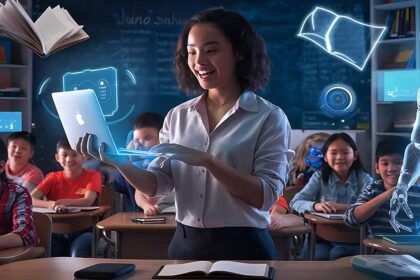In recent years, personalized learning has emerged as a revolutionary approach to education, driven by the integration of Artificial Intelligence (AI) and data analytics. Gone are the days when education was one-size-fits-all, where students had to follow a fixed curriculum and pace. Today, thanks to the power of AI and data, learning is becoming more tailored to individual needs, skills, and interests. This shift is poised to transform classrooms and educational systems around the world.
This article delves into how AI and data are enabling personalized learning, exploring the role of these technologies in modern education, their applications, benefits, challenges, and what the future of personalized learning holds.
1. Understanding Personalized Learning
Personalized learning refers to an educational approach that takes into account the individual learning styles, preferences, and abilities of each student. It aims to provide students with a learning experience that is tailored to their needs, allowing them to progress at their own pace, receive targeted feedback, and engage with content that resonates with their interests.
Unlike traditional education, which often follows a standardized curriculum, personalized learning offers flexibility in terms of the content, delivery method, and pace of learning. This student-centered approach not only enhances engagement but also improves overall academic outcomes.
2. The Role of AI in Personalized Learning
Artificial Intelligence is one of the key drivers behind the rise of personalized learning. AI can analyze vast amounts of data to identify patterns, track progress, and provide customized recommendations. It can also offer adaptive learning experiences that cater to the unique needs of each student.
2.1. Adaptive Learning Systems
AI-powered adaptive learning platforms are designed to adjust the difficulty of content and assignments based on a student’s performance. These systems collect data on how students interact with learning materials, including how long they take to answer questions, where they struggle, and how they respond to different types of content.
- Example: Platforms like Khan Academy, DreamBox, and Squirrel AI use AI algorithms to adapt lessons based on individual learning needs. For instance, if a student struggles with algebraic concepts, the system will provide additional resources and practice problems in that area, allowing the student to build a strong foundation before moving on to more complex topics.
2.2. Real-Time Feedback
AI enables real-time feedback, a crucial element of personalized learning. Traditional education systems often provide feedback only at the end of assignments or exams, but AI allows students to receive immediate responses to their work. This instant feedback helps students to recognize their mistakes and make corrections while the content is still fresh in their minds.
- Example: AI-powered systems like Grammarly for writing or Carnegie Learning for math provide students with instant, specific feedback on their work, enabling them to learn from their mistakes and progress more effectively.
2.3. Predictive Analytics
AI is capable of using data to predict future performance, allowing educators to anticipate challenges students might face. By analyzing past performance data, AI can identify patterns and predict whether a student might struggle with a specific concept in the future. Educators can then intervene early, providing additional support before problems escalate.
- Example: AI tools like Knewton use predictive analytics to identify students’ learning gaps and predict areas where they might need additional assistance. This enables educators to be more proactive and tailor their teaching strategies to individual student needs.
2.4. Natural Language Processing (NLP)
Natural Language Processing (NLP) is a subset of AI that allows machines to understand and process human language. In the context of personalized learning, NLP is used to create more interactive and personalized learning experiences. AI-powered chatbots or virtual assistants equipped with NLP can engage students in real-time conversations, answer their questions, and guide them through complex topics.
- Example: Virtual tutors powered by NLP can act as on-demand assistants, helping students to clarify doubts, review lessons, and guide them through difficult concepts, all in a conversational manner.
3. The Role of Data in Personalized Learning
Data plays a central role in the success of personalized learning. By leveraging educational data, teachers, and AI systems can gain insights into students’ strengths, weaknesses, preferences, and learning progress. This data-driven approach allows for the creation of highly individualized learning experiences that support student success.
3.1. Learning Analytics
Learning analytics refers to the collection, analysis, and use of data to improve educational outcomes. By tracking various metrics—such as student engagement, time spent on tasks, and performance on assignments—educators can better understand how each student learns and identify areas where additional support is needed.
- Example: Learning management systems (LMS) like Moodle, Canvas, and Blackboard collect data on student interactions with learning content, providing insights into their engagement levels. Teachers can use this data to adjust their teaching methods or provide targeted resources for struggling students.
3.2. Personalized Content Recommendations
Data allows AI to recommend specific content that is best suited to an individual student’s needs. This includes customized reading materials, practice exercises, videos, and interactive tools that match their current level of understanding. By using data from previous lessons and assessments, AI systems can create a personalized learning plan for each student.
- Example: Tools like Edmodo and Google Classroom offer personalized content suggestions based on a student’s past performance and preferences, helping them to engage with materials that are most likely to improve their learning outcomes.
3.3. Tracking Progress and Identifying Trends
By continuously collecting data, AI systems can track a student’s learning progress over time. This allows for continuous evaluation and adjustment of learning strategies. Teachers can identify trends, such as which types of content students perform best with, and adapt their instruction to suit.
- Example: Platforms like Classcraft track student progress and engagement in real-time, helping educators monitor trends and make data-driven decisions to improve classroom dynamics and outcomes.
4. Benefits of AI and Data in Personalized Learning
The integration of AI and data in personalized learning offers numerous benefits to students, teachers, and educational institutions.
4.1. Improved Student Engagement
By tailoring lessons to individual learning styles, interests, and paces, personalized learning helps keep students engaged. When students are allowed to explore topics they are passionate about and progress at their own pace, they are more likely to remain motivated and invested in their learning.
4.2. Increased Learning Efficiency
Personalized learning allows students to focus on areas where they need the most help, leading to a more efficient learning process. Instead of spending time on topics they have already mastered, students can skip ahead and challenge themselves with more advanced content.
4.3. Enhanced Learning Outcomes
With real-time feedback, adaptive lessons, and a learning path that is customized to their needs, students are more likely to succeed academically. Personalized learning has been shown to improve student performance and retention rates by catering to individual learning styles and needs.
4.4. Support for Diverse Learners
Personalized learning is particularly beneficial for students with different learning abilities, including those with disabilities or those who are gifted. AI and data can ensure that all students receive the support and resources they need, whether it’s additional assistance or more advanced material.
- Example: AI-powered tools can provide text-to-speech, speech-to-text, and other accessibility features to support students with disabilities, ensuring that all learners have equal opportunities to succeed.
5. Challenges of Implementing AI and Data-Driven Personalized Learning
While the potential of AI and data in personalized learning is vast, there are several challenges that educators and institutions must address to ensure successful implementation.
5.1. Equity and Access
One of the biggest challenges is ensuring equitable access to AI-driven personalized learning tools, especially in low-income or underserved regions. Technology gaps—such as a lack of devices, internet access, or sufficient digital literacy—can create disparities in educational opportunities.
5.2. Data Privacy and Security
With the collection of vast amounts of student data, privacy and security become significant concerns. Educational institutions must implement strict data protection measures to ensure that student information is safe from cyber threats and misuse.
5.3. Teacher Training and Support
For personalized learning to be effective, teachers need to be adequately trained in using AI and data analytics tools. It’s crucial that educators are comfortable with the technology and know how to interpret and act on the insights provided by AI-powered platforms.
5.4. Over-reliance on Technology
While AI and data can significantly enhance the learning experience, there is a risk of over-reliance on technology. Human interaction, empathy, and social learning are still essential components of education. Balancing technology with traditional teaching methods is critical for ensuring a holistic learning environment.
6. The Future of Personalized Learning
As we look to the future, the role of AI and data in personalized learning will continue to evolve. We can expect more sophisticated adaptive learning platforms, greater integration of AI-driven tutoring and support systems, and a more seamless connection between learning in the classroom and outside environments.
By 2025 and beyond, the education system will likely move closer to an ideal state of personalized learning, where each student has access to a unique, individualized educational experience powered by AI and data. Furthermore, advancements in AI will help remove the barriers to access, ensuring that more students around the world benefit from personalized education.
7. Conclusion
The integration of AI and data analytics into education is transforming the way we approach teaching and learning. Personalized learning, empowered by these technologies, has the potential to create more engaged, efficient, and successful students. While challenges such as equity, data privacy, and teacher training remain, the benefits far outweigh the obstacles. As AI and data continue to develop, they will play an increasingly critical role in shaping the future of education, making learning more adaptable, inclusive, and effective for all students.





